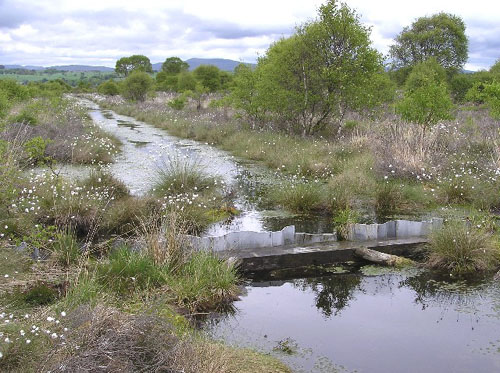SOME of Scotland’s most important assets in the fight against climate change are badly damaged, but can be repaired, a new report says.
The Scottish Wildlife Trust has undertaken the most comprehensive survey of lowland raised bogs in the last 15 years.
The Trust says it would cost £43,500 to bring a typical lowland raised bog to good condition. The capital cost of restoring all of Scotland’s lowland raised bogs to good condition is estimated at £21m.
Restoring the bogs, including the likes of Flanders Moss, could cost £21 million Photo:Paul Chapman
This money could come from many sources including business sponsorship of a local bog, lottery and rural development funding, or local people raising funds for a site near them. Lowland raised bogs would require annual investment to maintain their quality.
Lowland raised bogs develop in estuaries, valleys or small dips in the landscape. After the area is flooded, peat is formed as the lack of oxygen stops plants from breaking down. As more peat is created the surface is pushed above the surrounding area to create a distinctive dome shape – the ‘raised bog’.
Scotland’s lowland raised bogs are incredibly important. They comprise 40% of the lowland raised bogs of the UK and are amongst the rarest habitats in Europe.
Lowland raised bogs contain and trap a significant amount of carbon. Protecting them will contribute significantly towards meeting Scotland’s ambitious carbon emission targets, as well as protecting our valuable biodiversity.
Scottish Wildlife Trust Director of Conservation Jonathan Hughes, said: “This major survey has shown that almost all lowland raised bogs in Scotland are damaged. We found that 97% of sites had been artificially drained. Dry bogs lose their special plants and mosses and release carbon into the atmosphere. Rewetting such bogs is not only good for wetland wildlife, it is also good for the fight against climate change as wet bogs actively take up carbon dioxide from the atmosphere.
“The report has lots of grounds for optimism. We have estimated the cost to repair all our lowland raised bogs at just £21m, a small amount of money for the benefits it would bring society.
“We can also be optimistic that the owners of the bogs want to act as 95% of those we questioned were supportive of grant-aided restoration measures being carried out on their sites. The appetite is definitely there to do something about this problem.
“And we can make a huge difference. The majority of our raised bogs can be restored and we have the technical know-how. By removing woodland and scrub, installing dams to retain water and grazing sheep to inhibit scrub invasion, we can protect these little pockets of wilderness for generations to come.”
Minister for the Environment Stewart Stevenson said: “I am very happy to see this study. Scotland’s lowland raised bogs are remarkable ecosystems. While, as the report says, the majority have been disturbed over the years, it is encouraging that restoration is feasible in many cases and that good management does not need to be expensive. I welcome the positive steps in this report for land managers to protect and enhance these precious natural resources.”

